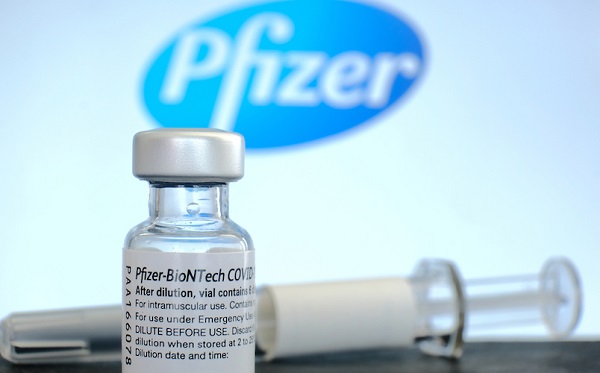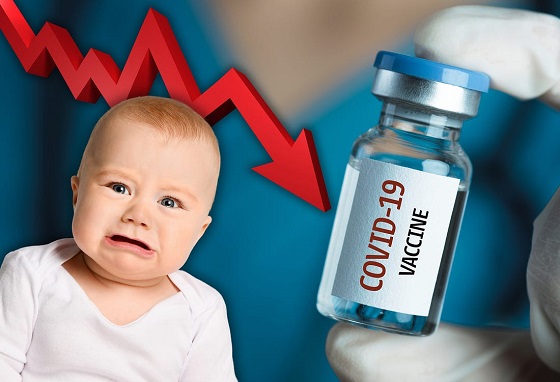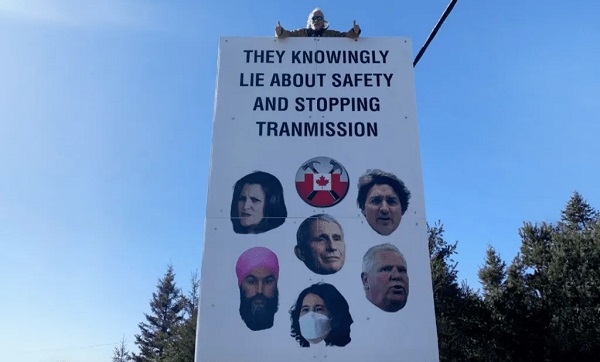COVID-19
Calls for COVID-19 vaccine recall – FDA’s own study finds DNA contamination in Pfizer vaccines

From LifeSiteNews
By Dr. Michael Nevradakis for The Defender
“It is alarming that the public is made aware of this contamination in an obscure journal that features high school science research. One has to ask, ‘Where is the FDA now?’ and ‘Why hasn’t the public been alerted of this?’”
The peer-reviewed study in the Journal of High School Science was authored by three high school students and performed at an FDA lab under the supervision of FDA scientists. The findings prompted renewed calls for a moratorium on COVID-19 vaccines.
A peer-reviewed study performed at a U.S. Food and Drug Administration (FDA) laboratory by high school students has confirmed the presence of a high level of DNA contamination in Pfizer’s mRNA COVID-19 vaccine.
The study, published December 29, 2024, in the Journal of High School Science, was authored by three students at Centreville High School in Clifton, Virginia, and performed under the supervision of FDA scientists.
Maryanne Demasi, Ph.D., an investigative medical reporter, was the first to report on the study.
READ: British doctor has medical license revoked over warning of COVID shot dangers
The research, performed at the FDA’s White Oak Campus in Maryland, found that levels of residual DNA in the Pfizer COVID-19 vaccine were 6 to 470 times higher than regulatory safety limits. The students tested two lots of the vaccine, finding they contained “residual DNA to a level that exceeds 10 ng [nanograms] per dose.”
“The potential health risk posed by residual small DNA fragments is currently unknown,” the study stated. However, the authors also said that DNA contamination may result in insertional mutagenesis – or DNA mutations – that can cause cancer.
Speaking last month on “The Defender In-Depth,” Kevin McKernan, who first identified DNA contamination in the shots in 2023, said DNA in vaccines can pose health risks because the DNA “could integrate into the genome and cause disruption of the genome … or it could disrupt other genes that are related to cancer.”
The FDA did not respond to multiple requests for comment on the study.
COVID vaccines ‘must be immediately recalled’
The new findings challenge “years of dismissals by regulatory authorities, who had previously labelled concerns about excessive DNA contamination as baseless,” Demasi wrote on Substack.
The findings also align with earlier reports from independent laboratories in the U.S., Canada, Australia, Germany, and France, she said.
McKernan, founder of Medicinal Genomics, told The Defender that eight studies have found DNA over the limit. “Very few studies are surveying a large number of lots, so each study is additive,” he said.
Epidemiologist Nicolas Hulscher said that in “light of this evidence, the COVID-19 genetic injections must be immediately recalled, to protect the public from further harm.”
Nikolai Petrovsky, Ph.D., director of biotechnology company Vaxine Pty Ltd., told Demasi that the findings are a “smoking gun” and that the new study “clearly shows the FDA was aware of these data.”
Christof Plothe, D.O., a member of the World Council for Health steering committee, agreed. He said:
So far, the European, Australian, and American health regulatory boards have denied any risks from plasmid DNA contamination in the COVID-19 injections despite nine studies by internationally known research teams.
All teams concluded that this contamination poses an unacceptable risk to three-quarters of the world’s population.… Three teams so far have demonstrated the integration into human cells. To what extent this is happening to everybody who was injected needs to be investigated.
READ: Children who got COVID shots more likely to catch the virus than those who didn’t, study finds
McKernan said that the FDA has long ignored evidence of the dangers posed by mRNA COVID-19 vaccines.
“The criteria for pulling these shots was established long before DNA contamination was first discovered,” he said. “I would hope that evidence of highly variable manufacturing would be grounds for immediate class 1 recall from the FDA. They are currently distracted with performing class 1 recalls on non-lethal hairspray.”
A Class 1 recall involves “a situation in which there is a reasonable probability that the use of, or exposure to, a violative product will cause serious adverse health consequences or death.”
According to Demasi, “The FDA is expected to comment on the findings this week. However, the agency has yet to issue a public alert, recall the affected batches, or explain how vials exceeding safety standards were allowed to reach the market.”
Plothe noted that Demasi presented evidence of DNA contamination to the FDA in September 2024, asking if the agency had launched an investigation or requested further testing of the mRNA vaccines by their manufacturers.
“Nothing resulted from this request,” Plothe said. “As nine studies have proven this severe contamination and repeated requests to health regulatory boards have not led to any consequence, we must ask about the motive.”
Brian Hooker, Ph.D., chief scientific officer for Children’s Health Defense (CHD), noted the irony of high school students discovering what the FDA has seemingly missed in the four-plus years since the vaccines’ introduction.
“It is ironic that it takes student researchers at the FDA to do the work of the FDA regulators,” Hooker said. “It is alarming that the public is made aware of this contamination in an obscure journal that features high school science research. One has to ask, ‘Where is the FDA now?’ and ‘Why hasn’t the public been alerted of this?’”
Demasi said that the significance of the new study’s findings is that they came from research performed at an FDA facility.
“Now that DNA contamination of the mRNA vaccines has been verified in the laboratory of an official agency and published in a peer-reviewed journal, it becomes difficult to ignore,” Demasi wrote. “It also places vaccine manufacturers and regulators in a precarious position.”
This article was originally published by The Defender – Children’s Health Defense’s News & Views Website under Creative Commons license CC BY-NC-ND 4.0. Please consider subscribing to The Defender or donating to Children’s Health Defense.
COVID-19
New Peer-Reviewed Study Affirms COVID Vaccines Reduce Fertility

Here’s what the numbers reveal, and what it could mean for humanity
What was once dismissed as a “conspiracy theory” now has hard data behind it.
A new peer-reviewed study out of the Czech Republic has uncovered a disturbing trend: in 2022, women vaccinated against COVID-19 had 33% FEWER successful conceptions per 1,000 women compared to those who were unvaccinated.
A “successful conception” means a pregnancy that led to a live birth nine months later.
The study wasn’t small. It analyzed data from 1.3 million women aged 18 to 39.
Here’s what the numbers reveal, and what it could mean for humanity.
First, let’s talk about the study.
It was published by Manniche and colleagues in the International Journal of Risk & Safety in Medicine, a legitimate, peer-reviewed journal respected for its focus on patient safety and pharmacovigilance.
The study was conducted from January 2021 to December 2023 and examined 1.3 million women aged 18–39. By the end of 2021, approximately 70% of them had received at least one COVID-19 vaccination, with 96% of the vaccinated cohort having received either the Pfizer or Moderna vaccine.
By 2022, a stark difference was clear.
The vaccinated cohort averaged around 4 successful conceptions per 1,000 women per month.
That’s a staggering 33% LESS than the 6 per 1,000 seen in the unvaccinated group.
This means that for every 2 vaccinated women who successfully conceived and delivered a baby, 3 unvaccinated women did the same.
In 2022, unvaccinated women were 1.5 times MORE likely to have a successful conception.
Again, that’s a conception that led to a live birth nine months later.
The authors did not jump to the conclusion that their study proved causation. They cited that other factors may have played a role, such as self-selection bias
However, the researchers noted that self-selection bias does not explain the timing and scale of the observed drop in fertility.
Moreover, birth rates in the Czech Republic dropped from 1.83 per 1,000 women in 2021 to 1.37 in 2024, adding further evidence that the COVID-19 vaccines may be contributing to the decline in fertility.
That downward trend, the researchers argue, supports the hypothesis that something beyond individual decision-making may be affecting conception rates.
As such, they argue that the study’s results warrant a closer and more thorough examination of the impact of mass vaccination.
If this study holds true, and vaccinated women are really much less likely to have successful conceptions, the implications for humanity are massive.
Millions of babies could be missing each year as a result of COVID vaccination, and recent data from Europe and beyond already point to a deeply disturbing trend.
NOTE: Europe experienced a sharper decline in births than usual from 2021 to 2023.
Live births fell from 4.09 million in 2021 to 3.67 million in 2023, marking a 10.3% decline in just two years.
The new Czech study adds to growing evidence that COVID vaccines may be contributing to a dramatic decline in fertility, just as many feared all along.
As Elon Musk warns, “If there are no humans, there’s no humanity.”
Whether the shots are the cause or not, the trend is real—and it’s accelerating.
It’s time to stop dismissing the signals and start investigating the cause.
Thanks for reading. I hope this report gave you real value. This is a critically important topic that deserves attention.
If you appreciate my work and want to help keep it going, consider becoming a paid subscriber.
99% of readers get this content for free. But just $5/month from the 1% keeps it flowing for everyone else.
If this work matters to you, this is the best way to support it.
Be the 1% who makes it possible.
Catch the rest of today’s biggest headlines at VigilantFox.com.
COVID-19
Ontario man launches new challenge against province’s latest attempt to ban free expression on roadside billboards

The Justice Centre for Constitutional Freedoms announces that Ontario resident George Katerberg has launched a legal challenge against the Ontario Ministry of Transportation for banning roadside billboards with social or political messages. Mr. Katerberg believes that the Ministry’s policies go too far and undermine the freedom of expression of all Ontarians.
This case goes back to March 2024, when Mr. Katerberg, a retired HVAC technician, rented a billboard on Highway 17 near Thessalon, Ontario, that featured images of public health officials and politicians alongside a message critical of their statements about vaccines.
After the Ministry rejected his proposed billboard several times on the grounds it promoted hatred, a constitutional challenge was launched with lawyers provided by the Justice Centre. Mr. Katerberg’s lawyers argued that the Ministry’s position was unreasonable, and that it did not balance Charter rights with the purposes of relevant legislation.
The Ministry later admitted that the sign did not violate hate speech guidelines and agreed to reconsider erecting the billboard.
However, in April 2025, the Ministry quietly amended its policy manual to restrict signs along “bush highways” to those only promoting goods, services, or authorized community events.
The new guidelines are sweeping and comprehensive, barring any messaging that the Ministry claims could “demean, denigrate, or disparage one or more identifiable persons, groups of persons, firms, organizations, industrial or commercial activities, professions, entities, products or services…”
Relying on this new policy, the Ministry once again denied Mr. Katerberg’s revised billboard.
Constitutional lawyer Chris Fleury explains, “By amending the Highway Corridor Management Manual to effectively prohibit signage that promotes political and social causes, the Ministry of Transportation has turned Mr. Katerberg’s fight to raise his sign into a fight on behalf of all Ontarians who wish to express support for a political or social cause.”
No date has yet been assigned for a hearing on this matter.
-

 Bruce Dowbiggin19 hours ago
Bruce Dowbiggin19 hours agoWhat Connor Should Say To Oilers: It’s Not You. It’s Me.
-

 Business20 hours ago
Business20 hours agoFederal fiscal anchor gives appearance of prudence, fails to back it up
-

 Business18 hours ago
Business18 hours agoThe Passage of Bill C-5 Leaves the Conventional Energy Sector With as Many Questions as Answers
-

 Alberta16 hours ago
Alberta16 hours agoAlberta poll shows strong resistance to pornographic material in school libraries
-

 Business14 hours ago
Business14 hours agoCanada should already be an economic superpower. Why is Canada not doing better?
-

 Crime15 hours ago
Crime15 hours agoFlorida rescues 60 missing kids in nation’s largest-ever operation
-

 Banks17 hours ago
Banks17 hours agoScrapping net-zero commitments step in right direction for Canadian Pension Plan
-

 Also Interesting2 days ago
Also Interesting2 days agoDodgers Hitting Their Stride: Winning Streak Sets Stage for Key Matchups















